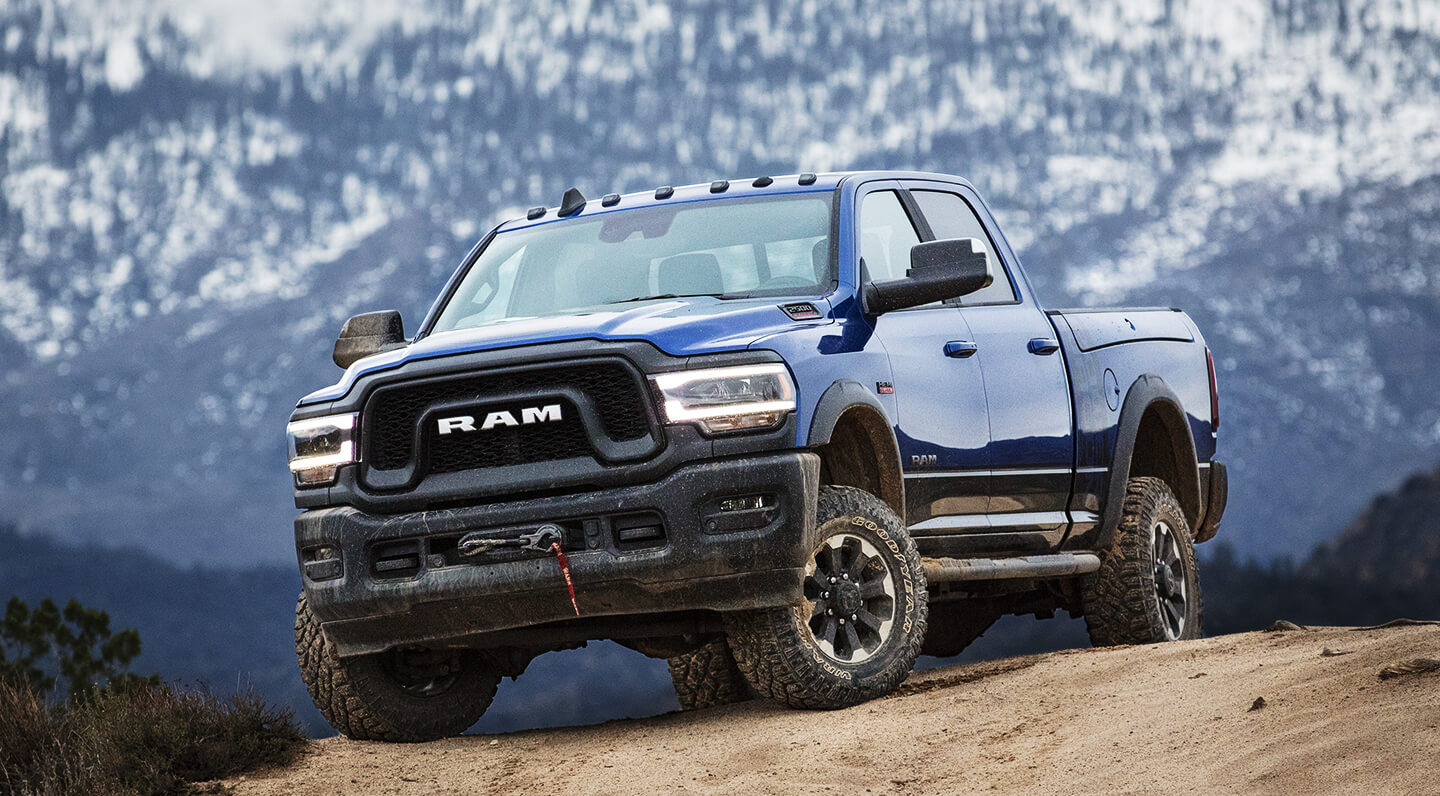
Say “Power Wagon” to a 4X4 fan and any number of highly-capable pickups stretching back over seven decades could come to mind. It’s one of the oldest and most revered marques in the four-wheel-drive world. But for most enthusiasts today, the name Power Wagon evokes images of a modern full-size Ram ¾-ton pickup with hardware built to handle serious trail work.
After a 25-year-long hiatus, Dodge resurrected and reimagined the Power Wagon for the 2005 model year. The new truck was a dream-come-true for full-size truck fans. The Power Wagon’s suspension was taller, it wore 33-inch tires, and had fully locking diffs front and rear for true four-wheel drive. You could even get a six-speed manual with a granny-low first gear which. When paired to the 4.56:1 gears, it made the Power Wagon the slow-speed trail champ. Best of all, engineers developed an impressive electronically actuated sway bar disconnect to free up wheel travel. It was a system Jeep would later use on the second-generation JK Wrangler Rubicon. And, if you got stuck, hidden in the front bumper was a factory Warn winch. Today, we’re very fortunate to have more than a few credible off-road packages with real capability. But back then, the Power Wagon was revolutionary.
Ram doesn’t specifically break out how many trucks they sell of a particular trim level. We guess that throughout the years, the truck maker has moved 1,000-4,000 Power Wagons per year (depending on the strength of the truck market). Those are relatively small numbers, but still enough for Ram to keep the truck alive with each new generation of Heavy Duty pickup.
The latest one was made new for 2019 wearing fresh bodywork, an upgraded powertrain and chassis, as well as a downright sweet interior package. The two things the team made sure to keep was all the off-road goodies (even improving some) and that badass retro “Macho” graphics package. We’ve always been fans of the big ‘Wagon. So, we couldn’t wait to slide behind the wheel of the new one. We put the nearly-loaded $67,220 beast through our usual battery of tests including a 300-mile road test and several hours four-wheeling. What’d we learn? Read on.
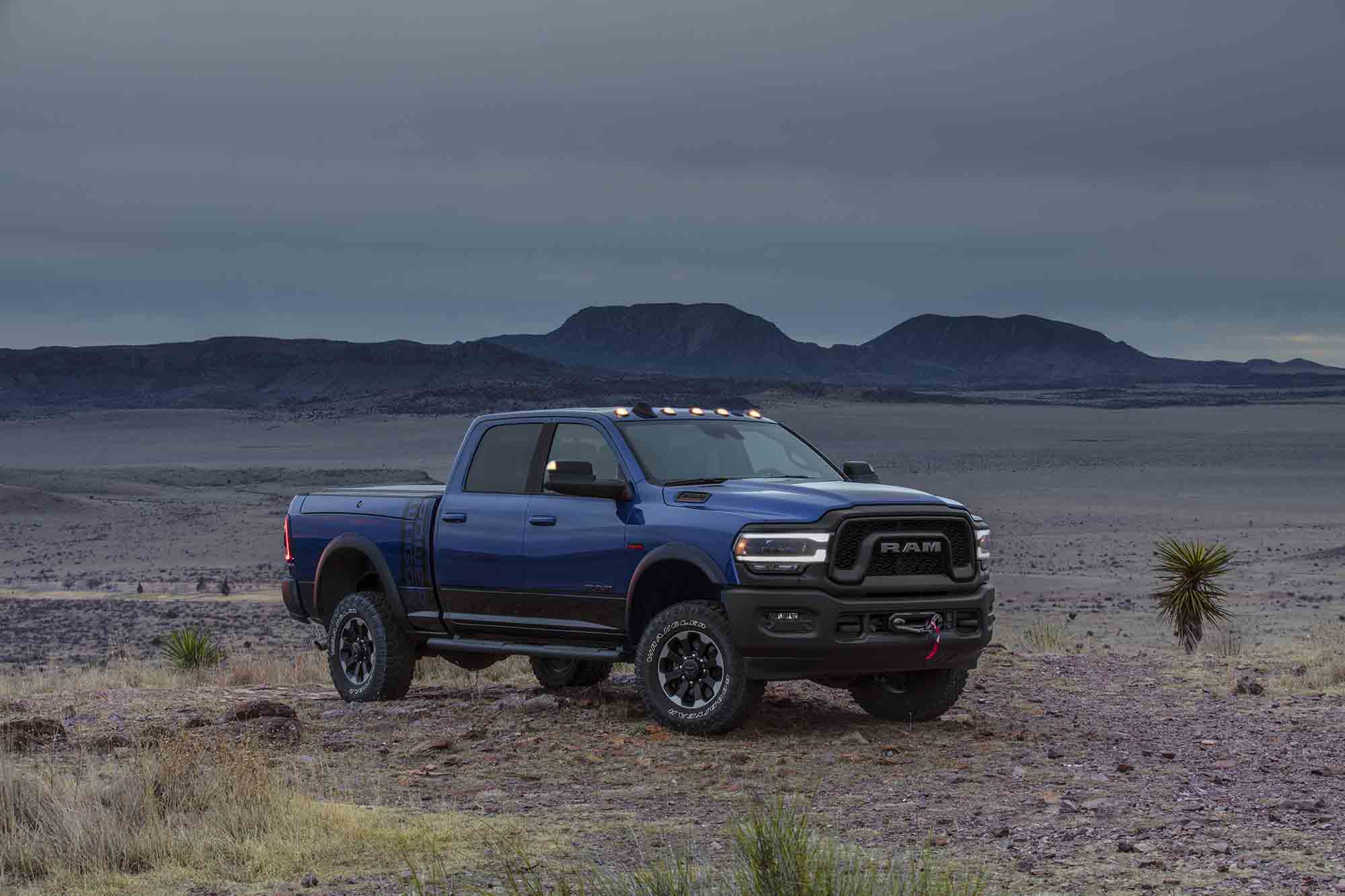
The Power Wagon wears the same wheels and tires as last year’s truck. And that means 285/70R17 Goodyear DuraTrac tires. Ram employed plenty of noise countermeasures for the new cab of its Heavy-Duty trucks. As a result, the aggressive Goodyears are reasonably quiet inside the ‘Wagon. Visually, the 2019 Power Wagon features new sheetmetal and headlights. Inside is a completely revised interior.
The Hardware
To the naked eye, the dimensions of the new Heavy Duty Rams look identical to last year’s truck. And in reality, they are so close you’d need to take very precise measurements to find a difference. The new wheelbase of 149.3-inches is just .2-inches shorter than last year. Length is up by less than an inch as are track widths. As close as the size of this new truck is to last year’s model, it does sit on an all-new frame and wear fresh bodywork.
The hydroformed front section and fully-boxed rear portion of the frame are almost 100 pounds lighter than the old one. The new frame is now almost entirely (98.5%) comprised of high-strength steels. Ram says this frame has the highest levels of torsional rigidity in the segment. The team also uses two Active-Tuned Mass Modules on the frame, which use electronically activated weights inside them to damp out unwanted forces.
Hung beneath those slabs of high-strength steel are familiar slabs of iron. The AAM 9.25-inch solid front axle now has improved pinion sealing upgrades internally to reduce noise and vibration. Similarly, the AAM 11.5-inch solid rear axle has a revised pinion angle to minimize noise and vibration.
The suspension design for both the front and rear of the truck are essentially the same as the outgoing truck. The springs are two-inches taller than the regular production Ram 2500 and use Bilstein dampers. In the front three links locate the axle. The upper axle mount is unique to the Power Wagon with increased movement. Like before, it’s called “Articulink” and it boosts axle twist by 15-20 percent over a regular Ram. And speaking of twist, press a button on the dash and the front swaybar will disconnect automatically and free up additional wheel travel. The rear suspension is still a five-link design with an additional damper mounted on top of the differential to curb axle wrap.
Both axles come with 4.10:1 gears and electronically-locking differentials. The axles receive torque from the same stout Borg-Warner 44-07 transfer case with a 2.64:1 low range as last year. And yes, it’s still operated by a good old-fashioned lever that sprouts from the floor of the cab.
The brake disc diameters of 14.1-inch front and 14.09-inch rear are identical to last year’s truck. But engineers revised the system with a new booster and master cylinder as well as improved calipers. All of it is to deliver better brake feel and shorter stopping distances.
Under the hood is Ram’s potent 6.4-liter Hemi V8 that generates 410 horsepower at 5,600 rpm and 429 lb-ft of torque at 4,000 rpm, just as it did last year. And yet, it may well feel more potent because backing this mighty engine is the new ZF 8HP75 eight-speed automatic with a deep 4.71:1 first gear and overdrive gears in seventh and eighth gears.
At the scales this beefy machine checked in at 7,440 pounds. Despite Ram touting some weight loss over the previous-generation truck, the new one was exactly 100 pounds heavier than the last one we tested. The Ram’s listed GVWR was 8,565 pounds and its rated to carry a payload of 1,165 pounds. It’s no surprise the Power Wagon can handle a sizable trailer—this is a 3/4-ton truck. The tow rating of 10,620 pounds is undoubtedly at the low end compared to Ram’s other Heavy-Duty trucks. But it’s 600 pounds more than the last Power Wagon we tested and enough to tow a couple of modestly built trail rigs on a good size trailer.
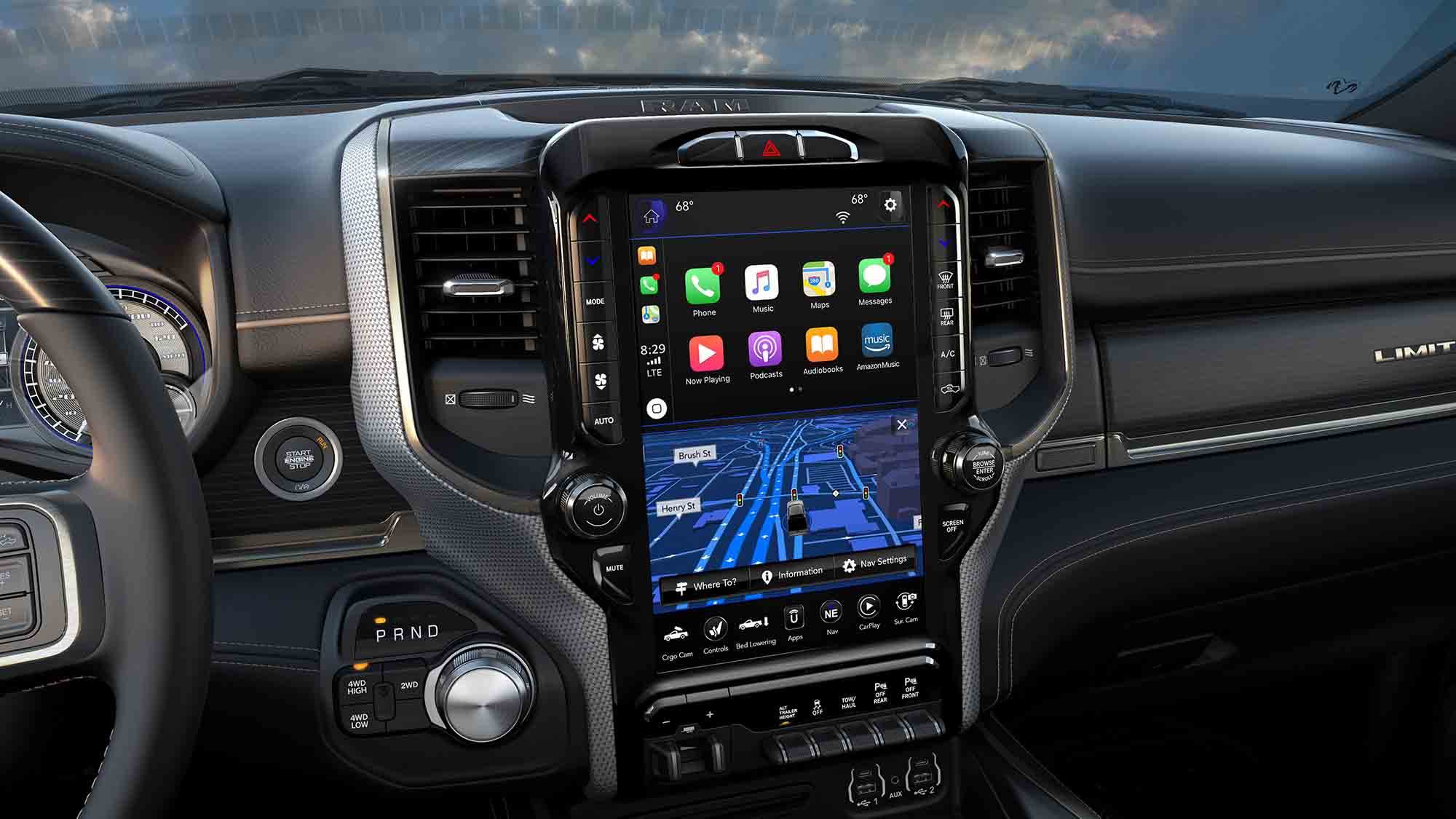
The cornerstone achievement for the new Ram Heavy-Duty trucks is the beautiful interior. The massive tablet-sized 12-inch infotainment screen is great to use but is an extra-cost option. We appreciate that 4WD lever on the floor but had a hard time getting comfy in the Ram’s seats.
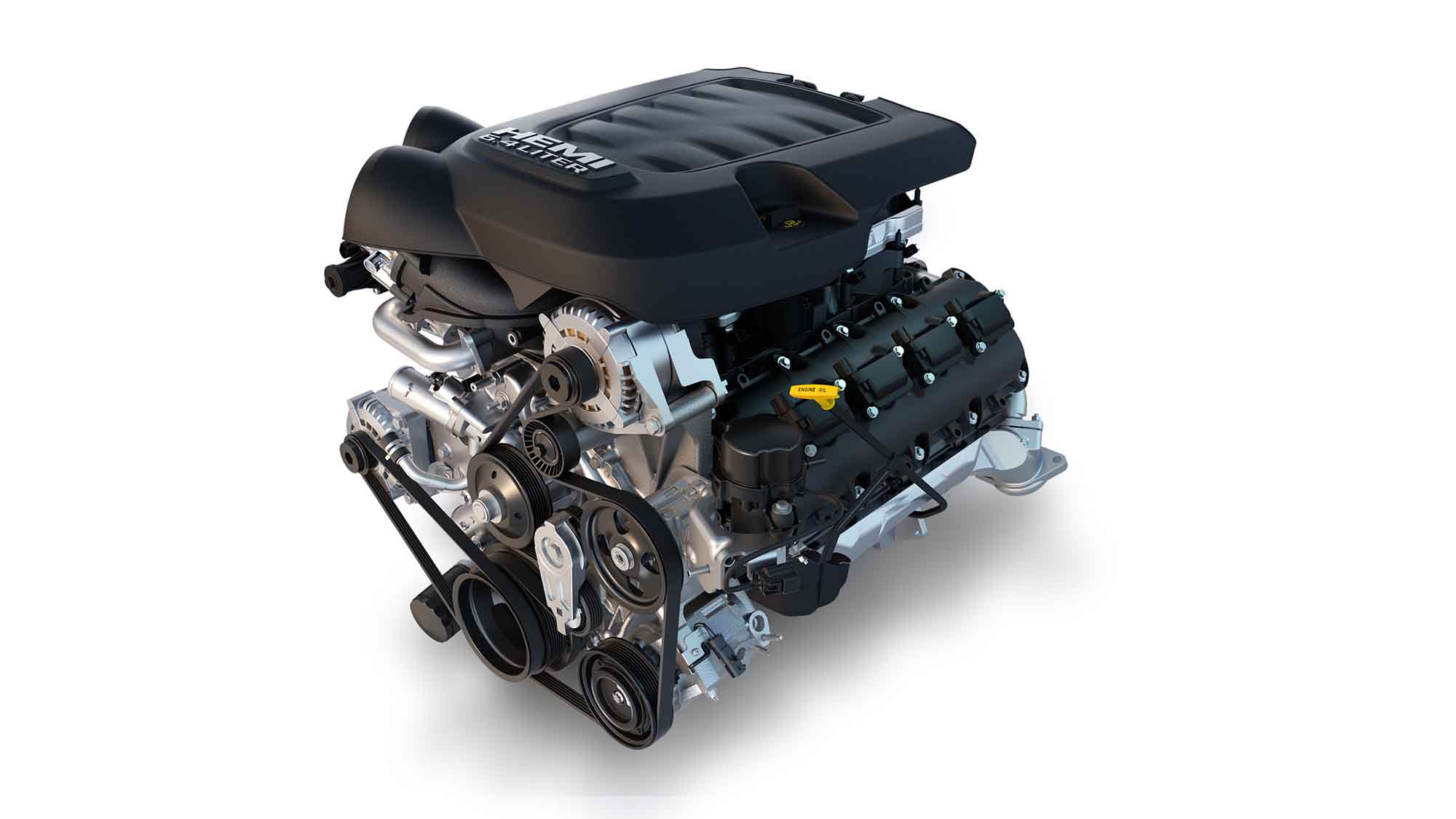
The Power Wagon’s 6.4-liter V8 hasn’t changed since the last generation and still belts out 410 horsepower and 429 lb-ft of torque. But the key to this truck feeling far sprightlier is the 8-speed automatic with a deep 4.71:1 first gear. It makes the 2019 Power Wagon feel like it has 40 more horsepower.
On the Street
It’s incredible what a difference a few gears in a good transmission can make. Despite an engine that hasn’t seen a bump in power or torque in half a decade, the 8-speed automatic transformed the way the Power Wagon feels. It’s noticeably quicker and more fun to throttle around town. It feels like the ‘Wagon suddenly gained 40 horsepower.
The rest of the driving experience isn’t unlike the previous-generation. The ride is still on the firm side and the steering is still a little slow. The Power Wagon’s suspension bucks on many of LA’s crappy freeways. It’s a gentle motion, but it’s consistent and downright annoying. Our level of tolerance might have been higher, but we had just spent a week with the smooth-riding GMC AT4. The difference between these trucks was huge. Yes, the Ram is a heavy-duty truck with massive axles to control. And the tires were at their recommended 65 psi. But still, we wouldn’t shy away from playing with air pressures as well as an aftermarket suspension and tires to try and improve the ride.
The ride may be a little rough. But at least those aggressive Goodyears are relatively quiet on the highway. And so is the whole Power Wagon experience. The team did an excellent job taming wind noise and making the on-road experience very pleasant. Part of that serenity comes from an engine that’s not spending much time up high in the rev range. Indeed, the torque-rich V8 was able to burble along at 2,000 rpm to maintain 70 mph most of the time. Only the steeper grades asked the 8-speed to drop a gear and raise revs to 2,500 rpm.
The experience inside the cab is loads better than the last truck. The new interior is sweet in just about every way. Perhaps the single best option is the $1,995 12-inch navigation screen. It’s beautiful to look at, easy to use, and makes the Ram the class leader for interior tech fitments. The same praise cannot be bestowed upon the seats, however. They’re flat and unsupportive places to sit for a long time. Ram needs to borrow the wonderful thrones in the SRT Jeep Grand Cherokee or Durango and use them in the Power Wagon. But aside from the seats, the new Power Wagon’s interior is a great place to spend time. The transmission shifter is a knob on the dash. But it works just fine and is an interesting contrast of old to new when you see that 4WD level on the floor.
Since this is a heavy-duty pickup there’s no EPA rating. But over our test route of freeway, city, and off-road driving the Power Wagon returned 13.5 mpg. That’s not great, but it is one full MPG better than the last Power Wagon we tested on the same route. Credit that eight-speed transmission and perhaps a more slippery shape.
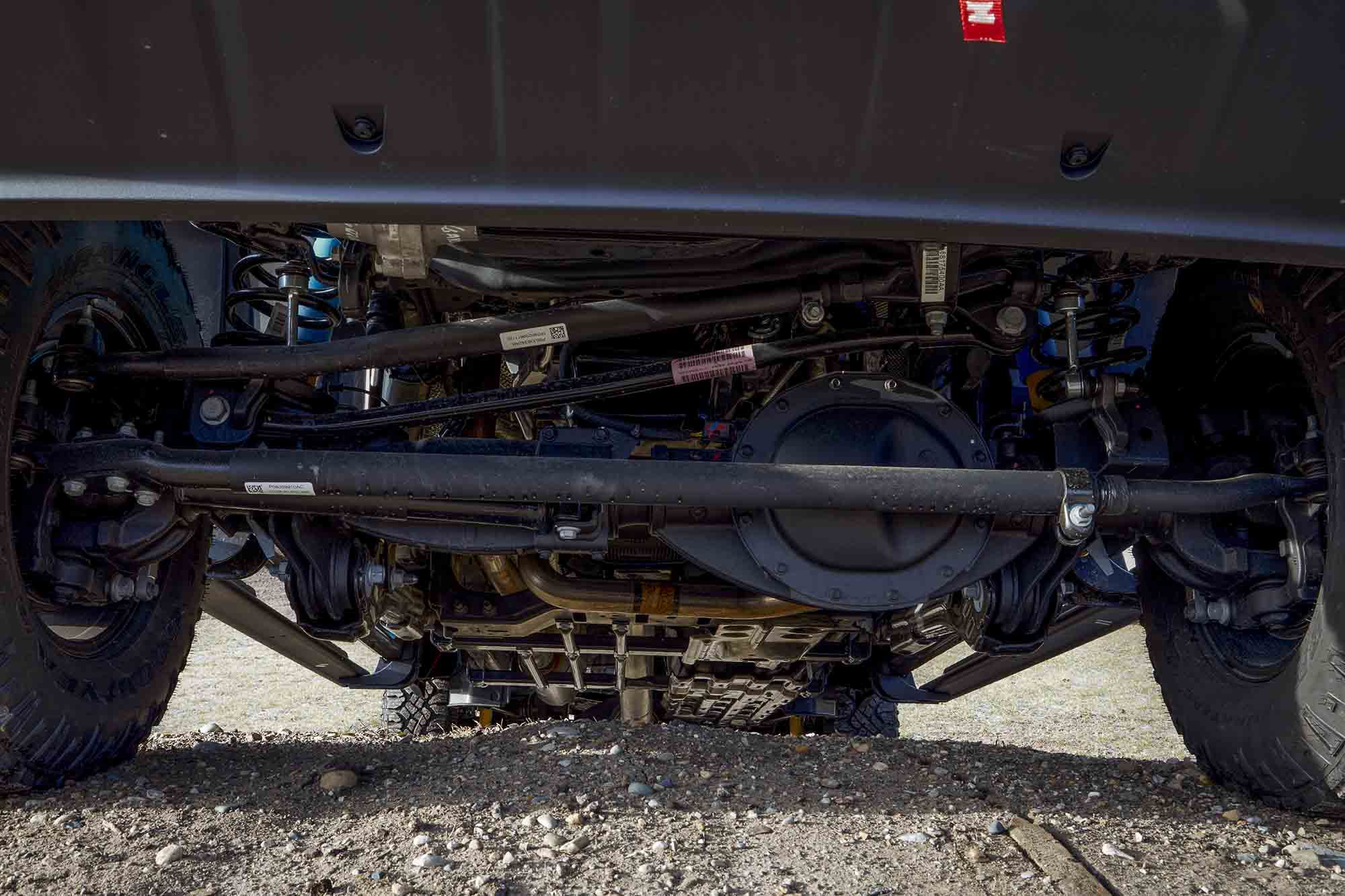
The familiar AAM 9.25-inch solid-axle comes with 4:10 gears and an electronic locking differential. It’s located by two lower links and one upper link with a unique Articulink joint that allows for more flex than a standard ¾-ton Ram. And speaking of twist, the electronic sway bar disconnect system is one of the key features to the Power Wagon’s impressive trail performance.
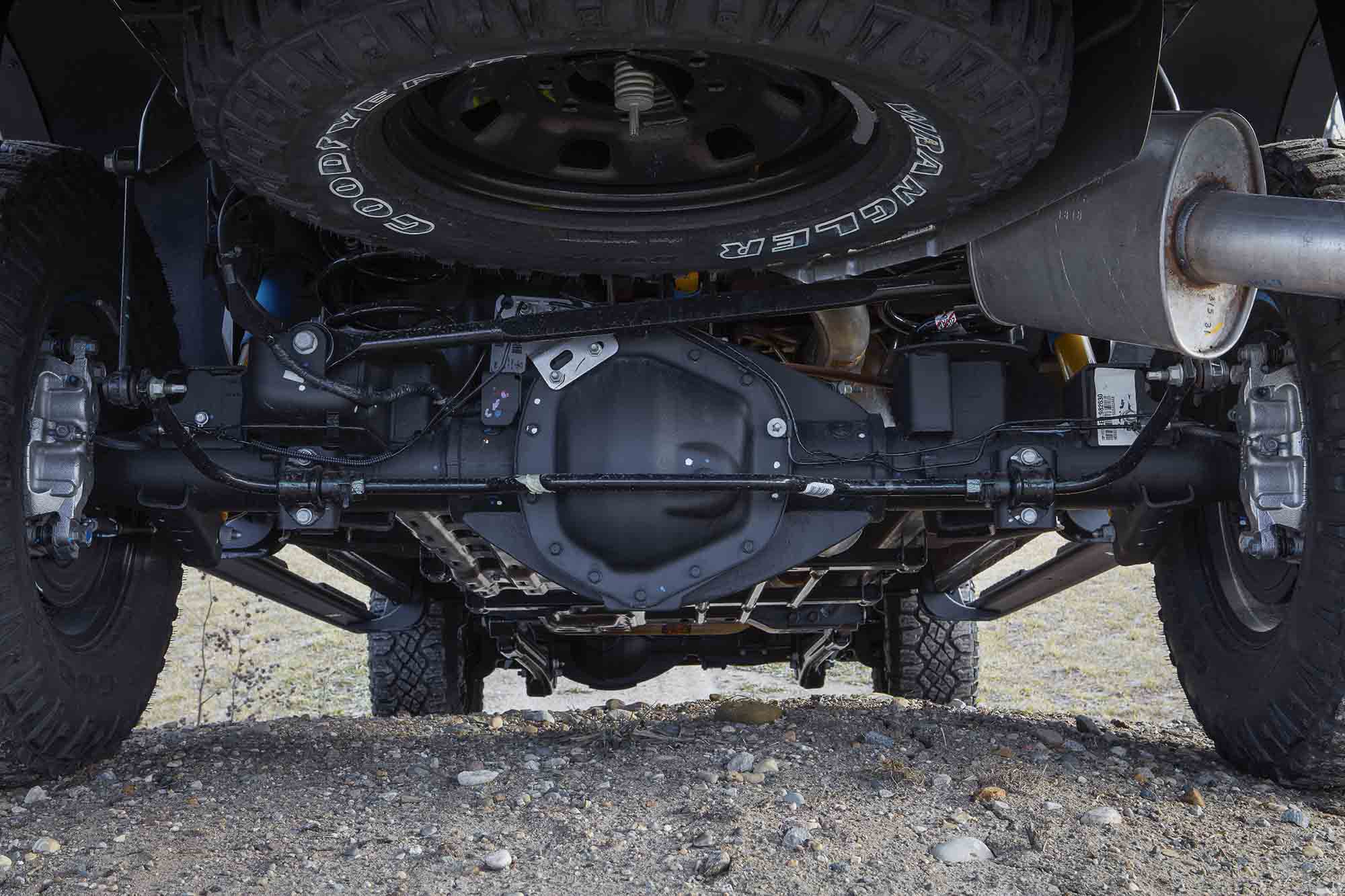
The rear AAM 11.5-inch axle has modifications to the pinion to help reduce noise. It also features an electronic locking differential along with 4.10 gears. The five-link rear suspension geometry is familiar to the previous generation and uses Bilstein dampers. The Power Wagon isn’t as adept at speed as the Ford Raptor, but it is surprisingly capable at a trail pace.
On the Trail
The new Power Wagon wears the same wheels and tires (285/70R17 Goodyear DuraTracs) as last year’s model. And because the axles are the same too, there’s still 9.25 inches under the front diff and 8.25 inches under the massive rear axle. Those aren’t big numbers. But once you hit the dirt, engage low range with that meaty lever, and unlock that front sway bar, the ‘Wagon has little trouble working its way through some really challenging sections. Yes, we drug the rear diff over a few obstacles. But the confidence this truck exudes makes you try stuff that you wouldn’t dare do in just about any other stock full-size truck.
To that point, we crisscrossed a fairly deep ravine and the ‘Wagon made it easily thanks to that incredible wheel travel and the security of locking diffs. But it’s still not as tall as a modified full-size truck. So, we kissed the rear bumper once and crunched down and mildly bent one of the $395 side steps. The lesson? Skip the side step option. Instead, get some retractable units or add a pair of rock rails. We’d also consider a larger tire or a bit more lift if this were our rig. Still, we pointed this big beast’s nose toward the toughest hill climb we do in the park. And with the rear diff locked it idled right up. There was no drama or spinning tires. It was easy for this capable machine.
Similarly, on our tough mogul field that maxes-out articulation, the Power Wagon walked right through with both diffs unlocked. Lock them up, and you can attack the trail and take any line you like. It’s like a three-and-a-half-ton Wrangler.
One wouldn’t imagine this behemoth sitting on relatively skinny mud tires aired to 65 psi would be any fun in the sand. But you’d be wrong. Just turn off the stability control and ease into the throttle to limit the mild rear axle hop. It’s pretty fun and flickable for such a massive truck. And, if you get bogged down in 2WD, that lever is really easy to slide into 4WD.
The off-road park has good, challenging terrain for a stock truck, but we never came close to being “stuck.” Unlike any other factory 4X4, the Power Wagon is equipped to get you unstuck with a Warn 12,000 lb. winch sitting behind the bumper. The 2019 Power Wagon’s winch uses new Zeon internals and tech versus the old M12. And it uses a lighter synthetic rope as well as a hawse-style fairlead.
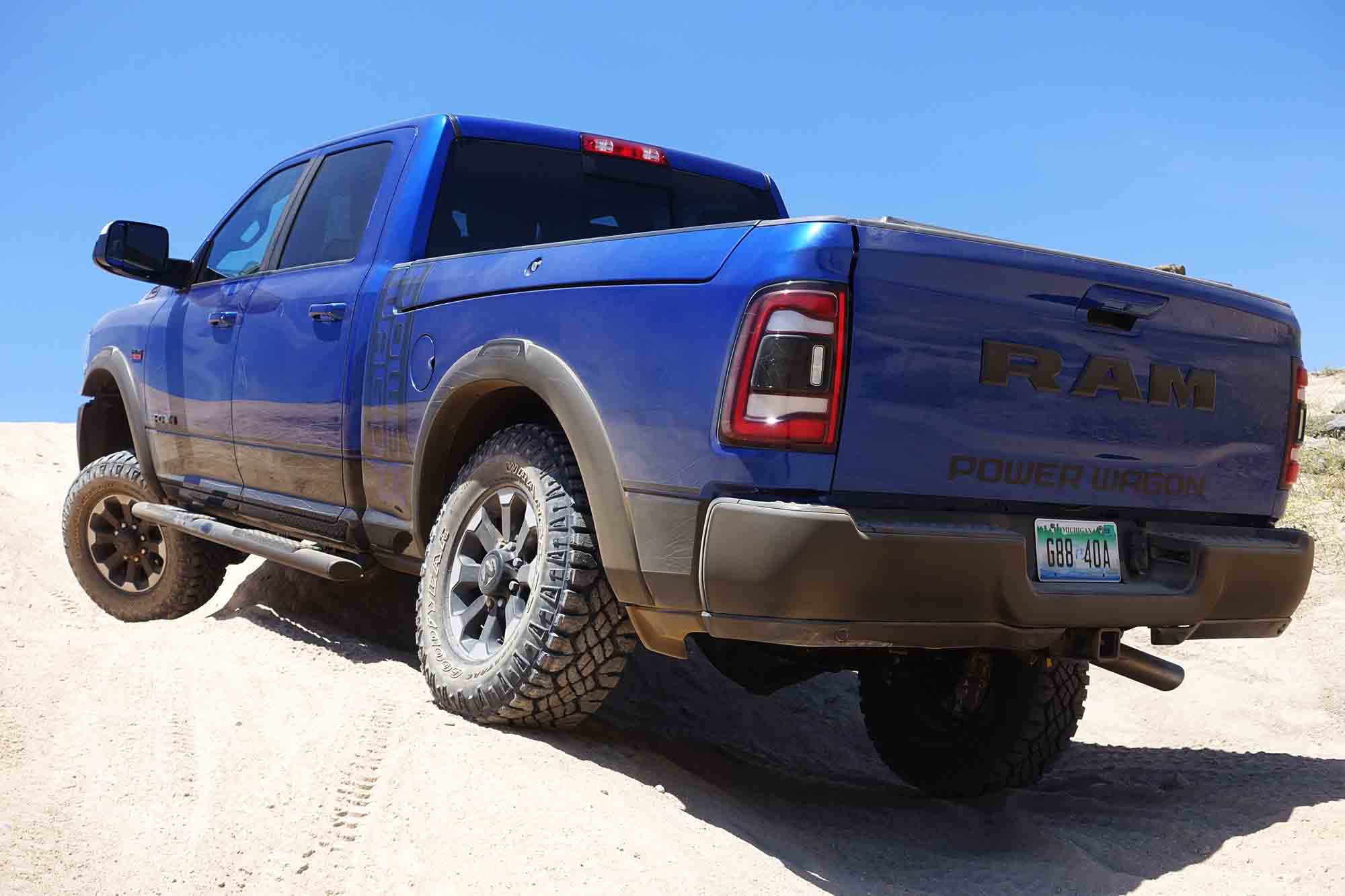
The Power Wagon is a talented machine off-road. But as we mentioned when we tested past models, this rig is begging for larger tires and a little more clearance. So, we’d explore the options to allow for slightly larger tires on the stock wheels.
The Bottom Line
The Power Wagon is in a class of one and has been since 2005. It’s a machine that excels in a wide variety of 4WD conditions. The upgraded powertrain and the sweet new interior make this rig a great place to spend time.
Like most trucks, the price of the Power Wagon has crept up over the years. Five years ago, we tested a somewhat loaded Power Wagon that stickered for $56,040. Three years later, we tested one that cost $62,610. And now this 2019 model will extract $67,220 from your bank account with more options available.
Sure, some trucks are more expensive. After all, luxury trucks are common now. But you don’t have to spend almost $70,000 for a Power Wagon. All the equipment that relates to this truck’s four-wheeling capability comes standard. And on this truck, the price of admission is $54,595. That’s not a bad deal at all for a heavy-duty full-size pickup truck that packs all the traction and trail prowess of a Power Wagon.



2